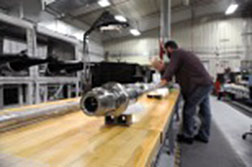- Number 432 |
- February 9, 2015
Accident-tolerant fuels ready for testing

Accident-tolerant fuel test samples are
prepared for irradiation at INL's Advanced
Test Reactor Test Train Assembly Facility.
Higher performance nuclear fuels could allow use in a reactor for longer periods of time along with enhanced tolerance to severe accident conditions. The summer of 2014 marked an important milestone toward development of nuclear fuel with enhanced accident-tolerant characteristics.
For several years, researchers in laboratories across the U.S. have designed, fabricated and tested a host of novel nuclear fuels and cladding materials (enclosed tubes that house the fuel). Now, testing of promising fuels and materials with enhanced accident tolerant characteristics is commencing in a U.S. nuclear test reactor.
Scientists and engineers from research labs and industry have prepared advanced concepts for insertion into the Advanced Test Reactor at DOE's Idaho National Laboratory. These efforts are central to DOE's Advanced Fuels Campaign.
The proposed light water reactor (LWR) fuel and cladding improvements center on an increased tolerance to postulated beyond design basis accident scenarios within a nuclear reactor. Several adjustments target fuel and cladding physical integrity under severe accident conditions, including enhanced retention of fission products and resistance to increased temperature. Certain novel compositions look at chemical properties as well.
Desirable performance attributes include increased power density, longer fuel cycle and operation to higher burnup. In other words, in addition to characteristics of enhanced accident tolerance, these new fuels have the potential to last longer and produce more energy.
For example, one technology of interest is silicon carbide-based cladding. Shannon Bragg-Sitton, the Deputy National Technical Director for the Advanced Fuels Campaign, explained the possible advantages this cladding could offer.
"In Fukushima, the fuel's zirconium cladding reacted with high temperature steam to produce hydrogen. This ultimately resulted in the explosions that were observed when the hydrogen was combusted," Bragg-Sitton said. "A silicon carbide cladding would still react with high temperature steam, but the reactions would occur at a much slower rate with massively reduced hydrogen production. Responders would have more time to mitigate the problem."[Suzanne Baker, 208.526.7785,
suzanne.baker@inl.gov]
